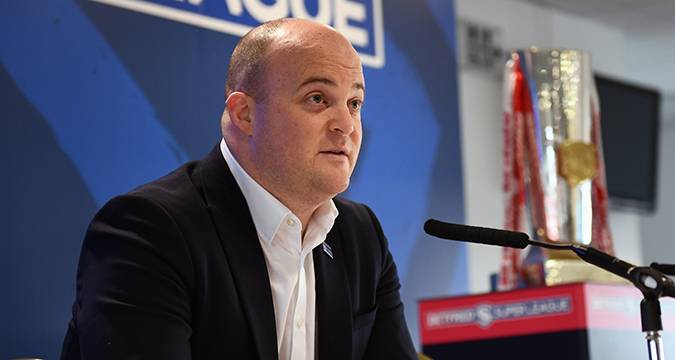
By AARON BOWER
RUGBY LEAGUE Commercial CEO Rhodri Jones is confident that Super League’s new TV deal with Sky Sports can yield a similar financial return to the existing contract, although he admits there is “a lot of hard work to get to that point” ahead.
Sky saw off competition from rival broadcasters to agree a three-year deal with Super League in the region of £21.5 million per year, which is £2.5 million down on the existing contract. That shortfall will likely be felt in the pocket of clubs, but no decisions on central distribution for 2024 will be made until the middle of next month.
Jones admits that it was a relief to have the deal concluded after a lengthy negotiating process, and he insists that, despite reports in some quarters of interest from the likes of DAZN and TNT Sports, Sky’s deal was the best offer for the sport.
“I guess the positive from it taking so long is because we managed to get some competition in the market, and create some tension,” said Jones.
“That means you deal with different broadcasters. The landscape has changed too, so there was that, but secondly there was that competitive tension which we haven’t had on the last two occasions we’ve negotiated.
“Sky have been the sport’s biggest supporter in the last 30 years, but ultimately when we compared the offers on the table, the Sky one stood out and that was our recommendation to clubs.
“It provided us with security, it provides us with coverage that we’re used to and consistent with – and of course, every game now being produced by Sky and having video referees means the game is governed on a level playing field. The free-to-air allowance (League Express understands 17 games will be made available free to air, as opposed to ten over each of the last two seasons) is still there, and it was a better deal on paper for the clubs.”
The Sky deal comes with less money but with the possibility of further income elsewhere. They will produce – but not broadcast – every single Super League game, allowing for both the introduction of competition-wide video referees as well as the prospect of selling rights for the games Sky choose not to show elsewhere, or potentially streaming them on an improved OurLeague.
“The goal for the sport is to make its own in-house platform commercially viable to generate the shortfall in money the new TV deal brings, which Jones admits is high on the agenda.
“It’s definitely part of the plan,” added Jones.
“What OurLeague looks like going forward is something we need to consider. It’s going to be more akin to a TV channel, perhaps. We can’t lose sight of the reason it was created, which was a membership platform for supporters of the game, but the plan is for a lot more content on there.”
Sky’s bid was chosen over DAZN’s, partly because the online broadcaster wanted the entire sport to be broadcast on its own platforms and nowhere else. In choosing Sky, there is now the prospect of going to market with the free-to-air allowance allocated by Sky Sports – and Jones admits there will be conversations with multiple broadcasters, not just Channel 4.
“The Sky deal being agreed means we can now start those conversations with some clarity in terms of knowing what our free-to-air allowance is,” Jones said.
“It might be slightly different to what it is and what it looks like currently, and we’ll certainly have a very positive conversation with Channel 4. But that’s not to say it will be the only conversation.
“The BBC have supported Rugby League for over 50 years, and ITV have shown plenty of rugby union. Is there a dual-code opportunity there? Who knows, but that’s to name just three broadcasters.”
Clubs are now nervously waiting to find out how the finances surrounding the new deal impacts the money they receive via central distribution – but they will not find out until the middle of next month at the earliest. A 30-day period, during which the finer details of the contract will now be agreed has begun, and only after that will clubs be presented with financial budgets.
“The central funding and distribution for clubs is still to be determined,” Jones said.
“We’ve done some provisional maths at our end but there’s an RL Commercial board meeting on September 13th, when version one of the 2024 budget will be presented.
“After that, everyone will have the first indication of what the distributions will look like in 2024. Everyone is factored into the financial equation now and we’re all in it together; if we go up, everyone wins, but if we go down, everyone will have to feel some of that pain. Our challenge is to mitigate some of the detail and get a great deal for everyone.
“We need to get everything down into a formal piece of paper. At the moment, everything is subject to contract, and that needs to go through a legal process. Hopefully we’ll do it quicker than 30 days, but 30 days is a realistic target.”
